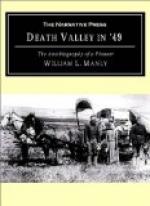The Santa Anita ranch, now owned by E.J. Baldwin, was owned by Henry Dalton, an Englishman, who came with a stock of goods worth $75,000, years before, but now had only the ranch left. The Azuza, a short distance south was occupied by his brother.
I became well acquainted with many of these old California natives, and found them honest in their dealings, good to the needy and in all my travels never found more willing hands to bestow upon relatives, friends or strangers ready relief than I saw among these simple natives. Their kindness to our party when we came starving on the desert in 1850, can never be praised enough, and as long as I shall live my best wishes shall go with them.
I was one day riding with Vincent Duarte down toward Anaheim when he suddenly dismounted to kill a large tarantula by pelting him with stones. It was the first one I had seen, and seemed an over-grown spider. I asked him if the thing was harmful, and he replied with considerable warmth, “Mucho malo por Christianos” and I wondered if the insect knew saints from sinners.
This spring we concluded to go to the Mormon settlement at San Bernardino and secure some American bulls to improve our stock, and starting late one day I rode as far as the Azuza Rancho where I staid all night with Mr. Dalton, reaching the holy city, a branch of Brigham Young’s harem next day. Here I found a town of log houses in a circle, enclosing a plaza. There was a passage between the houses. I stopped at the principal hotel kept by a vigorous and enthusiastic Mormon woman, who delighted to preach the doctrine.
Walking around on the outside of the fortifications I came across Capt. Hunt, the man who was hired in the fall of 1849 to bring the big train from Salt Lake to San Bernardino.
I told him who I was, and what I wanted, and he seemed to know me, inviting me in the most friendly and social manner to take supper with him, which I did. He sat at the head of the table and introduced me to his three wives. The furnishing of the house was cheap and common, but the table was fairly provided for. He said he would help me to find the animals I wanted, and in the morning showed me two which he had, that were young and suitable, and a larger one which he said I could have if I could drive him.
I soon found out that I had better move or sell my cattle, for with all my watching I could do they gradually disappeared, and hungry thieves who could live on beef alone, visited my little band of cattle too often and took what they wanted, and I could not detect them. I soon sold to four buyers from the north, L.D. Stevens, David Grant, Sam Craig and Mr. Wilson, and hired out with my two horses to help them drive the band north, at a salary of $100 per month.
Disposing most of my money with Palmer, Cook & Co., I went to see my mine at Moore’s Flat. There were two boats leaving at about the same time, one for Stockton, and one for Sacramento, the latter of which I took, and Rogers the other. Both landed at Benecia, and when we swung away from that wharf Rogers and I saluted each other with raised and swinging hats, shouted a good bye, and I have never seen him since.




